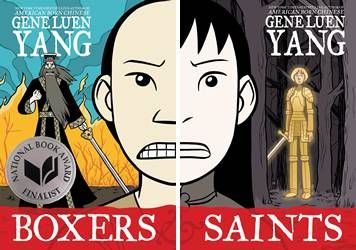
On Research: What it Takes to Research a Story
Once a month, Gene Luen Yang, the National Ambassador for Young People’s Literature, stops by Book Riot Comics for Creativity in Progress, a minicolumn on art, process, and how he creates comics.
In his book Story, screenwriting guru Robert McKee describes three types of research that storytellers can do. Memory Research is when you sift through your own experiences, often from childhood, to find a story. Imagination Research is when you set aside time to map out the details of a fictional character, event, or world. Book Research is what we usually think of when we hear the word “research.” This is when you read books and articles to learn about new facts and ideas.
When I first started making comics, I didn’t think about research at all. Even so, research was a part of my process. All my early stories were inspired by my own life experiences, so I was doing Memory Research.
For instance, my first self-published graphic novel was called Gordon Yamamoto and the King of the Geeks. It’s about a high school kid who gets a spaceship stuck in his nose and becomes friends with an alien that’s driving the ship. That idea came from my life. I’ve never had a spaceship stuck in my nose, but I have had a lifelong struggle with sinus problems. For some reason, one of my nostrils is always plugged up.
One day I got to thinking, what if something sentient was causing the problem in my nose? I didn’t realize it at the time, but all my sinus-related memories from childhood were research materials for my first graphic novel.
The first project that I consciously considered research was Boxers & Saints, a two-volume graphic novel about the Boxer Rebellion. It took me six years to finish. About a fourth of that time was devoted to research.
I first became interested in the Boxer Rebellion in the year 2000 when Pope John Paul II canonized a group of Chinese Catholic saints. I grew up in a Chinese Catholic community, and my home church freaked out about the Pope’s announcement. They had all sorts of celebrations and special Masses, which inspired me to look into the lives of these newly canonized saints. I discovered that many of them had been martyred during the Boxer Rebellion, a war that was fought on Chinese soil in the year 1900. They were killed because, back then, Chinese who embraced Western faith were seen as traitors to their families, their nations, and their culture.
The more I read about the Boxer Rebellion, the more intrigued I became. I wanted to do a project about it, but I was also really intimidated. I didn’t know a thing about the Boxer Rebellion. I wasn’t a history major and I didn’t know anything about research.
I tried pushing the idea aside, but I couldn’t seem to get rid of it. It had a hold on me.
I began making weekly visits to my local university library. I would go every Wednesday after work and spend a few hours reading every book I could find about the Boxer Rebellion and turn-of-the-century China. I was fascinated by what I was learning, but I was also motivated by fear. I was afraid that no matter how much research I did, I would still get something wrong. I was afraid that after the book came out, some professor who knew more about the Boxer Rebellion than me would e-mail to tell me I got something wrong.
I did these weekly library trips for about a year and a half, and I could have gone on for much longer. In the end, I got myself to stop by realizing that I didn’t need to re-create turn-of-the-century China. With my more contemporary stories, I didn’t re-create suburban America in its every detail. Instead, I created a believable, cohesive cartoon world based on suburban America. In the same way, what I really had to do for Boxers & Saints was create a believable, cohesive cartoon world based on turn-of-the-century China.
Since that project, I’ve consciously built research into every one of my projects. I try to do at least one of Robert McKee’s three types of research, no matter what the topic.
In early 2016, I began working on New Super-Man, a monthly DC Comics series about teenage Super-Man from China. To prepare, I did Memory Research by remembering what it was like to be a 17-year-old. I did Imagination Research by thinking through how superheroes would be received in modern China. And I did Book Research by reading book and articles about Chinese politics and Chinese life. My favorite was Age of Ambition by Evan Osnos, winner of the 2014 National Book Award for Non-fiction.
Research is now one of my favorite parts of my process. I feel that improves not just the quality of my stories, but also the quality of my life.
After all, research is all about learning, and what’s more fun than learning?


















